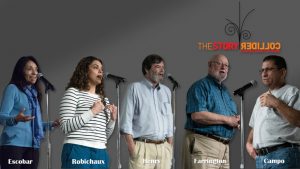C-IMAGE Partners with Story Collider to Share Oil Spill Science Stories
– MARCH 16, 2017
(From Winter 2017 Newsletter) On February 6, 2017, the Center for Integrated Modeling and Analysis of Gulf Ecosystems (C-IMAGE) and the Story Collider teamed up to feature five speakers who shared their stories surrounding the Deepwater Horizon oil spill. The event took place in New Orleans, Louisiana.
The Story Collider is a New York-based storytelling show created in 2010 by two physicists dedicated to providing a forum for scientists to share their personal stories about science. The Story Collider continues to host shows across the country and has expanded into a podcast series. This Story Collider event was hosted by Ari Daniel, digital producer of NOVA and a freelance science reporter for public radio, and Erin Barker, host and artistic director of the Story Collider.
The event featured five storytellers sharing their connections to the Deepwater Horizon oil spill and oil spill science. Most speakers began their stories with where they were when they received news of the 2010 Deepwater Horizon oil spill.
Charlie Henry, Director of the National Oceanic and Atmospheric Administration (NOAA)’s Gulf of Mexico Disaster Response Center opened the show, sharing a “behind the scenes” look at oil spill response from his more than 30 years of experience in the field. He shared that the gravity of responding to oil spills is never lost on him; one mistake can result in additional damage to ecosystems or even cost someone their life.
Elva Escobar-Briones, Director of the Instituto de Ciencias del Mar y Limnologia at the Universidad Nacional Autonoma de Mexico, and member of the C-IMAGE consortium, shared her memories of her first ever dive in a submersible to study hydrothermal vents. In particular, she fondly recalled the three course lunch she was treated to (including French wine!) at the bottom of the ocean and the warm reception she received upon returning to the surface, which ironically included a bucket of ice water poured over her head! To this day, she still tries to convey that same kindness and enthusiasm during her dives and to all of her graduate students.
John Farrington, Dean Emeritus of the Woods Hole Oceanographic Institution and member of the Gulf of Mexico Research Initiative’s Research Board shared his experiences having worked in oil spill science for more than four decades. When he first learned of the Deepwater Horizon spill, Dr. Farrington thought, ”not again.” He recalled his experiences responding to and studying the Ixtoc I oil spill in Mexico, which occurred in 1979. Ixtoc I has many parallels to Deepwater Horizon and has become an important part of C-IMAGE’s research.
Estelle Robichaux, a senior restoration project analyst at the Environmental Defense Fund, told of her experiences with the Deepwater Horizon oil spill as both a native of Louisiana and also as a graduate student studying wetlands at the time of the spill. She shared how watching the impact of oil spill on her home state inspired her to follow a career path in which she continues to advocate for restoration and conservation of coastal wetlands.
Robert Campo is a commercial oyster fisherman in Shell Beach, Louisana. His family has owned and operated Campo’s Marina for more than 117 years. He learned of the Deepwater Horizon oil spill when a reporter called him to ask about it while out fishing. Even seven years later, Mr. Campo said some areas still haven’t produced a single oyster. He said it’s hard to think that he may have to consider doing something else, after having been in the business for his entire life.
The Story Collider event brought together five unique stories and perspectives surrounding the Deepwater Horizon oil spill. For many other science stories, visit the Story Collider website here. To view videos from the Story Collider event C-IMAGE hosted at the 2016 Gulf of Mexico Oil Spill and Ecosystem Science Conference in Tampa, FL, visit C-IMAGE’s YouTube Channel here.







